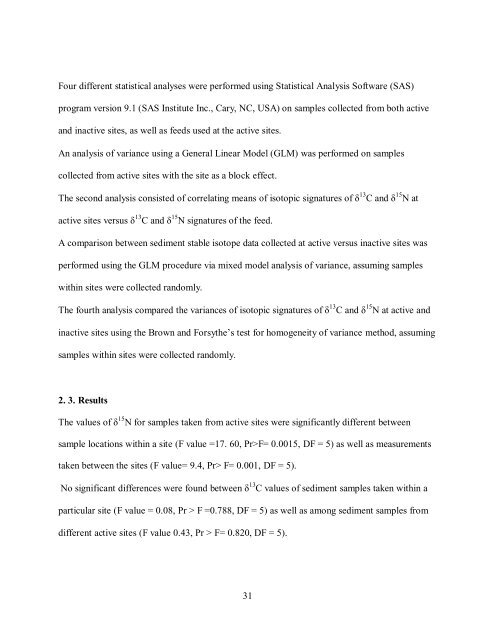Role of Temperature and Organic Degradation on the Persistence of ...
Role of Temperature and Organic Degradation on the Persistence of ...
Role of Temperature and Organic Degradation on the Persistence of ...
Create successful ePaper yourself
Turn your PDF publications into a flip-book with our unique Google optimized e-Paper software.
Four different statistical analyses were performed using Statistical Analysis S<str<strong>on</strong>g>of</str<strong>on</strong>g>tware (SAS)<br />
program versi<strong>on</strong> 9.1 (SAS Institute Inc., Cary, NC, USA) <strong>on</strong> samples collected from both active<br />
<str<strong>on</strong>g>and</str<strong>on</strong>g> inactive sites, as well as feeds used at <strong>the</strong> active sites.<br />
An analysis <str<strong>on</strong>g>of</str<strong>on</strong>g> variance using a General Linear Model (GLM) was performed <strong>on</strong> samples<br />
collected from active sites with <strong>the</strong> site as a block effect.<br />
The sec<strong>on</strong>d analysis c<strong>on</strong>sisted <str<strong>on</strong>g>of</str<strong>on</strong>g> correlating means <str<strong>on</strong>g>of</str<strong>on</strong>g> isotopic signatures <str<strong>on</strong>g>of</str<strong>on</strong>g> δ 13 C <str<strong>on</strong>g>and</str<strong>on</strong>g> δ 15 N at<br />
active sites versus δ 13 C <str<strong>on</strong>g>and</str<strong>on</strong>g> δ 15 N signatures <str<strong>on</strong>g>of</str<strong>on</strong>g> <strong>the</strong> feed.<br />
A comparis<strong>on</strong> between sediment stable isotope data collected at active versus inactive sites was<br />
performed using <strong>the</strong> GLM procedure via mixed model analysis <str<strong>on</strong>g>of</str<strong>on</strong>g> variance, assuming samples<br />
within sites were collected r<str<strong>on</strong>g>and</str<strong>on</strong>g>omly.<br />
The fourth analysis compared <strong>the</strong> variances <str<strong>on</strong>g>of</str<strong>on</strong>g> isotopic signatures <str<strong>on</strong>g>of</str<strong>on</strong>g> δ 13 C <str<strong>on</strong>g>and</str<strong>on</strong>g> δ 15 N at active <str<strong>on</strong>g>and</str<strong>on</strong>g><br />
inactive sites using <strong>the</strong> Brown <str<strong>on</strong>g>and</str<strong>on</strong>g> Forsy<strong>the</strong>’s test for homogeneity <str<strong>on</strong>g>of</str<strong>on</strong>g> variance method, assuming<br />
samples within sites were collected r<str<strong>on</strong>g>and</str<strong>on</strong>g>omly.<br />
2. 3. Results<br />
The values <str<strong>on</strong>g>of</str<strong>on</strong>g> δ 15 N for samples taken from active sites were significantly different between<br />
sample locati<strong>on</strong>s within a site (F value =17. 60, Pr>F= 0.0015, DF = 5) as well as measurements<br />
taken between <strong>the</strong> sites (F value= 9.4, Pr> F= 0.001, DF = 5).<br />
No significant differences were found between δ 13 C values <str<strong>on</strong>g>of</str<strong>on</strong>g> sediment samples taken within a<br />
particular site (F value = 0.08, Pr > F =0.788, DF = 5) as well as am<strong>on</strong>g sediment samples from<br />
different active sites (F value 0.43, Pr > F= 0.820, DF = 5).<br />
31
















